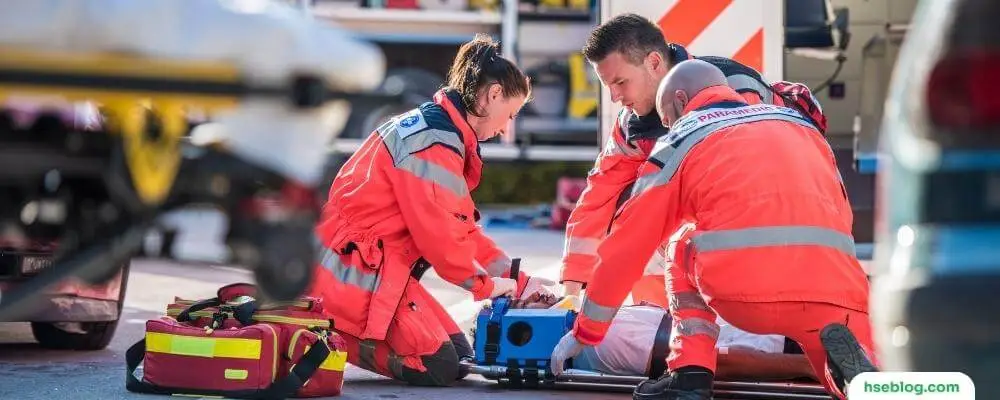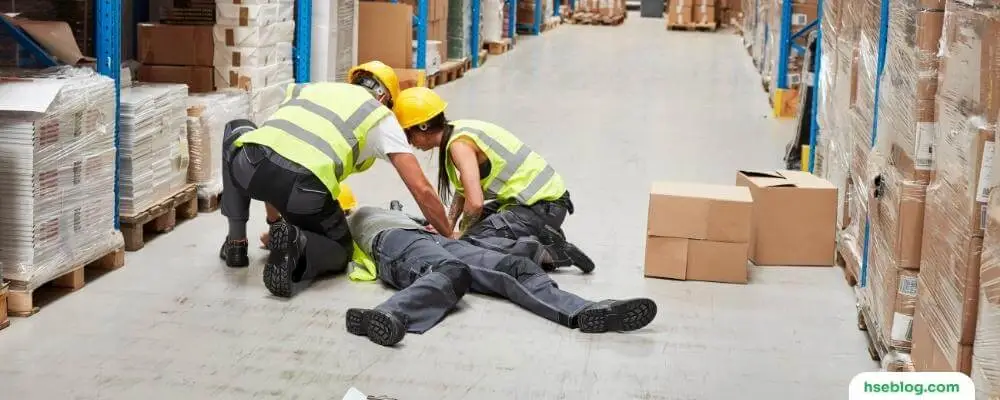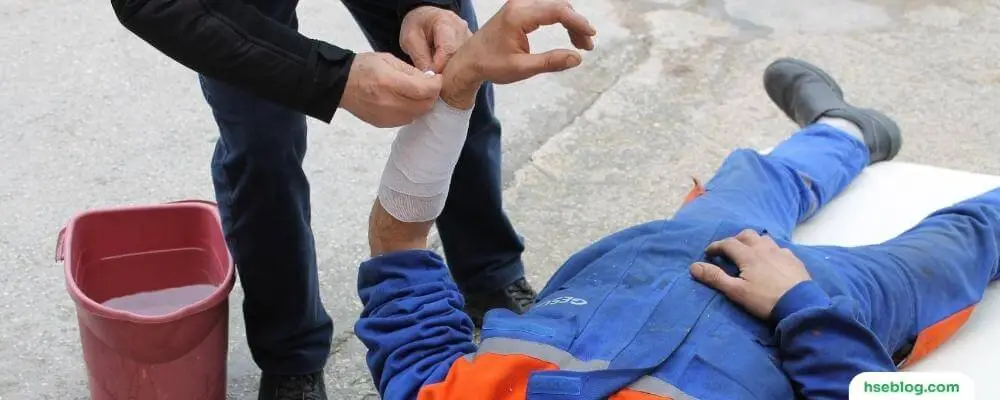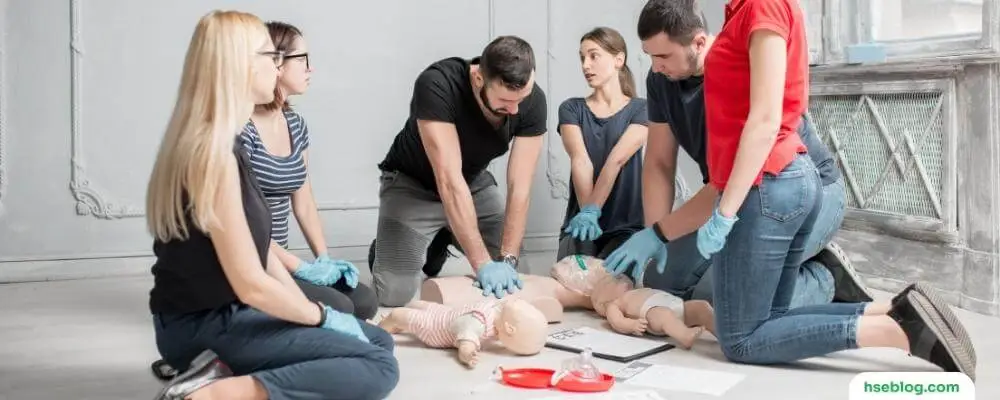When accidents happen, the first few minutes can be the most critical in determining the outcome. Here is where the concept of first aid comes into play. But what is first aid? And why is it so crucial? In this blog post, we delve into the definition of first aid and then highlight its importance by detailing ten compelling reasons why everyone should have a basic understanding of this lifesaving skill.
From saving lives to creating safer communities, the impact of first aid extends far beyond the individual, becoming a vital component of our collective well-being. Whether you’re a parent, teacher, employer, or just an average citizen, the knowledge of first aid can prove invaluable in numerous situations. Read on to learn more about first aid, and why it is a skill set we should all strive to acquire.
What is First Aid?
First Aid is the immediate help or care given to someone who has suffered from an injury or illness until full medical treatment is available or until the crisis is resolved. It can involve a simple action, such as placing a bandage on a cut, or something more complex, like administering CPR (Cardiopulmonary Resuscitation) when someone’s heart has stopped.
The primary goals of First Aid, often referred to as the “Three P’s”, are:
- Preserve Life: This is the main aim of any first aid procedure. It involves trying to save lives by providing essential treatment and stabilizing the patient before professional medical help arrives.
- Prevent Further Harm: The first aider ensures that the patient is kept from any cause of harm and prevents the injury or illness from worsening.
- Promote Recovery: First Aid also includes speeding up the patient’s recovery process. This could be by applying a plaster to a small wound or by performing CPR and helping to restore normal body functions.
It’s important to note that First Aid does not replace professional medical help. It is a critical initial step for providing effective and swift action that helps to reduce serious injuries and improve the chances of survival.

What is First Aid at Work?
First Aid at work refers to providing immediate and initial medical assistance given in a workplace setting during an emergency, injury, or illness before professional medical help arrives. The main aim of workplace first aid is to preserve life, prevent the condition from worsening, and promote recovery.
Every workplace must ensure that employees are provided with adequate and appropriate equipment, facilities, and trained personnel to immediately assist employees if they are injured or become ill at work.
First aid at work can include several measures:
- First Aid Kits: All workplaces should have a fully stocked first aid kit readily available. The kit’s contents may vary depending on the nature of work, the size of the organization, and potential workplace hazards. Still, generally, they include bandages, antiseptic wipes, tweezers, sterile gauze, adhesive tape, scissors, and gloves, among other things.
- First Aid Training: Some employees are given formal training in first aid to become designated workplace first-aiders. The training typically covers how to respond in emergencies, basic life support, knowledge of common workplace injuries, and how to use first aid equipment.
- Emergency Procedures: Workplaces also have emergency procedures in place, which include instructions on what to do in case of an emergency, how to raise the alarm, evacuation procedures, and where to gather after evacuation. Employees are often trained on these procedures.
- Record Keeping: It is common practice to record workplace injuries and illnesses, including details of any first aid treatment provided. These records can help identify patterns in injuries and illnesses and can be useful for improving workplace safety measures.
- First Aid Rooms: In larger workplaces, there may be a dedicated first aid room or health centre where trained health professionals can provide and manage health emergencies until additional medical help arrives.
The specific regulations and requirements for first aid at work can vary significantly from one country or state to another, and businesses need to understand and comply with their local laws.

10 Reasons Why First Aid is Important?
First aid is crucial in emergency situations as it provides immediate care and assistance to individuals who have been injured or are in distress. Here are ten reasons why first aid is important:
1. Saving Lives
The fundamental objective of first aid is its life-saving potential. Emergencies often unfold unexpectedly and can swiftly become fatal without immediate intervention. First aid serves as that critical initial response, providing care vital for the survival of a victim of injury or illness. Before professional medical help arrives, first aid can maintain essential bodily functions and prevent the situation from worsening during this critical period. Take, for instance, performing cardiopulmonary resuscitation (CPR) on someone experiencing cardiac arrest, a situation where time is absolutely critical and an immediate response can make the difference between life and death.
Similarly, in cases of severe allergic reactions, the quick administration of an EpiPen can mitigate life-threatening symptoms and sustain the individual until they receive professional medical care. First aid bridges the gap between the onset of an emergency and the arrival of professional help, often making the difference in life-threatening situations.
2. Reducing Pain and Discomfort
First aid isn’t just about dealing with life-threatening situations but is also crucial in managing non-life-threatening conditions that may cause substantial pain or discomfort. This can involve many injuries, from minor cuts and bruises to sprains, strains, or burns. A trained first aider has the skills to provide immediate relief for these conditions, alleviating pain and making the victim more comfortable until professional help is available or necessary.
For instance, they may correctly dress a wound to prevent further trauma and reduce pain or apply a cold compress to a sprain or strain to limit swelling and numb the area, thereby reducing discomfort. These interventions, while seemingly minor, can profoundly impact a person’s immediate well-being and recovery trajectory, highlighting the significance of first aid beyond dire emergencies.

3. Preventing Further Injury or Illness
One of the critical aspects of first aid is the prevention of further injury or illness. When a medical emergency occurs, the situation or environment might pose additional risks to the victim. A trained first aider knows how to manage these situations to protect the individual from further harm. For instance, in the case of a car accident, they might need to move the injured person away from the wreckage if there’s a risk of explosion or fire.
If someone has potentially fractured a limb, immobilizing that limb can prevent further damage to surrounding tissue and complications like internal bleeding. It also helps in reducing the pain experienced by the victim. Similarly, in case of burns, first aid might involve covering the burn with a clean, non-stick bandage to protect it from infection. All of these actions are about stabilizing the victim’s condition, ensuring it doesn’t worsen before professional medical help can arrive, and highlighting the preventive aspect of first aid.
4. Promoting Recovery
The promptness and efficiency of first aid can directly influence the speed and efficacy of the recovery process. By providing immediate care, first aid can reduce the severity of an injury or illness, promoting quicker recovery. For example, when properly cleaned and dressed immediately after an injury, a wound is less likely to get infected, ensuring a quicker healing process. This also minimizes the risk of future complications like scarring or tissue damage.
Similarly, in severe emergencies like cardiac arrest, starting CPR at the earliest can ensure the blood flow to the brain is maintained, reducing the risk of severe brain damage due to oxygen deprivation. These interventions, while simple, can make a substantial difference in the patient’s recovery journey, underscoring the importance of first aid.

5. Enhancing Medical Communication
When a person is trained in first aid, they possess the skills to provide immediate assistance and the understanding to effectively communicate the patient’s situation to arriving medical professionals. This can include the details about the nature of the injury or illness, the symptoms exhibited by the individual, the first aid steps already taken, and the person’s response to these steps.
Having this information allows healthcare providers to understand the situation swiftly, which is crucial, especially in emergencies where every second counts. Therefore, This well-informed communication can expedite the diagnosis and treatment process, ensuring that the patient receives appropriate and timely medical care. Moreover, it can help medical professionals decide on the need for further tests or treatments, making the medical intervention process more efficient and effective.
6. Improving Safety in the Workplace
Workplaces, particularly those with a higher risk of accidents, such as construction sites, manufacturing plants, or even kitchens, benefit enormously from having staff trained in first aid. Accidents, injuries, and health crises can occur without warning in these environments. Employees with first aid training are equipped to respond to these incidents immediately, providing vital initial care that can minimize the severity of injuries or even prevent fatalities.
This rapid response can make the difference between minor and major injuries. Furthermore, first aid-trained staff can foster a general safety culture, as these individuals often become advocates for risk prevention, raising awareness about potential hazards and encouraging safer practices among their colleagues. Thus, first aid knowledge doesn’t just help in the aftermath of an accident; it can also contribute to a safer, more mindful working environment.

7. Increasing Personal Confidence and Calmness during Emergencies
First aid training does more than just equip individuals with life-saving skills; it also imbues them with confidence and calmness when confronted with emergencies. Instead of descending into panic or feeling helpless when witnessing an accident or medical emergency, those trained in first aid can maintain a level-headed approach guided by their knowledge and training. They know the right steps to take, from assessing the situation and ensuring safety to providing necessary immediate care and communicating effectively with emergency services.
This confidence isn’t merely beneficial for the individual needing assistance; it can also create a calming influence on bystanders and reassure them that help is underway. By fostering a controlled, systematic approach to emergencies, first aid training is vital in reducing panic, promoting effective intervention, and increasing overall chances of a positive outcome.
8. Reducing Hospital Stays and Medical Costs
Prompt and efficient first aid significantly impacts healthcare economics by potentially reducing the length of hospital stays and overall medical costs. When immediate care is administered effectively, it can prevent minor injuries from escalating into more severe, complicated conditions. For instance, properly cleaning and dressing a wound right after an injury could prevent subsequent infection, which would otherwise require additional treatment and potentially an extended hospital stay.
Similarly, the swift application of a splint to stabilize a fractured bone could prevent further injury, reducing the need for complex surgical intervention. By mitigating the severity of an injury through first aid, the need for extensive medical procedures can be lessened, which could lead to a reduction in overall medical expenses. Consequently, first aid serves as a critical element in health preservation and a potential cost-saving measure within the larger healthcare system.

9. Boosting Employability
Having first aid skills and certification is a valuable asset that can enhance an individual’s professional profile and make them more attractive to employers. This is especially true for certain job roles where the health and safety of others are a significant aspect of the work, such as teachers, lifeguards, coaches, or construction site supervisors. In such positions, having employees trained in first aid can improve the overall safety and preparedness of the organization.
Furthermore, employers may view individuals with first aid training as responsible, proactive, and equipped with problem-solving skills, which are highly sought after in many professions. As a result, first aid knowledge can provide an edge in competitive job markets, increasing one’s employability by demonstrating a commitment to the well-being of others.
10. Ensuring Child Safety
With their curious minds and boundless energy, children are often at risk of accidental injuries, from minor cuts and bruises to more serious falls or choking hazards. As such, first aid knowledge is particularly essential for those who live or work with children, including parents, teachers, and caregivers. Understanding how to react in these situations can dramatically alter outcomes, reducing the severity of injuries and even preventing fatal incidents. This includes knowing how to appropriately clean and bandage a wound, perform the Heimlich manoeuvre, or react to potential poisoning.
Additionally, this knowledge extends beyond emergency response to preventative measures, creating a safer environment for children to explore and grow. Overall, having first aid skills is critical in ensuring children’s safety, well-being, and healthy development.
Conclusion
In conclusion, first aid is an immediate and interim form of care provided to a person suffering from an injury or illness, designed to sustain life, prevent the condition from worsening, and, in some cases, promote recovery. The knowledge and skills associated with first aid are invaluable, from saving lives and preventing further harm to promoting faster recovery, reducing healthcare costs, and creating safer environments.
By increasing our individual and collective understanding of first aid, we contribute to a healthier, safer society where each one of us can potentially make a critical difference in a moment of need. Thus, first aid isn’t just a personal asset; it’s a vital societal tool for improving health outcomes and enhancing communal well-being.

